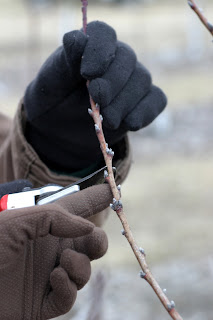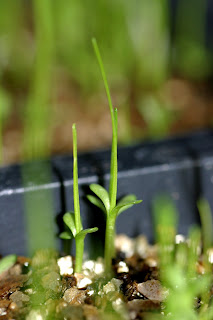 Richard Heter
Richard Heter, Horticulturist - Grounds & Natural Resources, kneels beside one of our fallen big trees of Powell Gardens. Last year, a storm blew down our largest
Shagbark Hickory Carya ovata, the same day the patriarch of Powell Gardens, George Powell, Jr. passed away. The tree fell across our nature trail and Richard cut a swath through it so school children and hikers could pass and experience this massive tree. The fallen tree will become the home for many creatures and replenish the woodland soil. We must remember trees are mortal too.

The tree has 92 rings at a height of more than 15 feet. Hickories grow notoriously slow when young, concentrating their energy on an amazing tap root so that they can survive the vagaries of the Midwestern weather (This tree may have been 150 years old). This is why this beautiful tree is never for sale in nurseries -- you can't grow a saleable tree in two years. A hickory takes time, which is also money anymore. No one is willing to pay $25 for an 18-inch tree even though it would be a wise investment in the future.
Because of our fallen hickory we wanted to make sure we knew where all the big trees on our 955 acres are. Powell Gardens was originally more than 60 percent prairie according to the original land surveyor's notes, but there was forest along our creek and in scattered pockets. Powell Gardens has some huge trees in its remnant woodlands. Richard has begun measuring the top three largest of each native species. The inventory will help us make better land management decisions: as the great conservationist Aldo Leopold said, "The first step in intellegent tinkering is to save all the parts."

It is very hard to photograph a huge tree. Here Richard stands beside our largest
Northern Red Oak Quercus rubra. Richard is over 6 feet tall and a former football player! The buttressed base of this tree is nearly 6 feet across.

Here Richard inspects our tallest Shagbark Hickory. The characteristic shaggy bark is farther up the trunk which soars up around 50 feet before its first branch. We have not yet taken this tree's measurements -- it's possibly near 100' tall.

There are several massive
Sycamores Platanus occidentalis along our creek. At 6 feet in diameter, they have a long way to grow because when the land was settled many were reported so massive and hollow they could be a makeshift shelter for cattle!

I always admire the spectacular crown of sycamore trees in the winter. This is the crown of the sycamore Richard was looking up at. The highest branches are certainly over 100 feet up. Sycamores shed their bark to sluff off any vines that may try to climb up in their crown and compete for sunlight. The fresh new bark is always a chalky white and beautiful against the winter sky. Sycamores remain a strong tree even though they grow fast and naturally hollow out with age. Their hollow trunks were the original home of Chimney Swift birds, which now nest in chimneys.
Sycamores were the largest tree in eastern North America in overall size. Eastern White Pines and Tulip Trees may have been taller but never as massive. They are not a good tree for a small yard but are at home along a river, creek or swale where they are native.
We will have more on Powell Gardens' big and old trees in a future blog. We are thankful for and inspired by Chuck Brasher of Kansas City, MO, for keeping track of Greater Kansas City's big trees (Jackson and Clay Counties in Missouri and Johnson and Wyandotte Counties in Kansas). You can see Chuck's roster of the Greater KC's big trees on our website
http://www.powellgardens.org/.
All photographs taken by Alan Branhagen on January 8, 2008 at Powell Gardens.






















































